Related Research Articles

A trolleybus is an electric bus that draws power from dual overhead wires using spring-loaded trolley poles. Two wires, and two trolley poles, are required to complete the electrical circuit. This differs from a tram or streetcar, which normally uses the track as the return path, needing only one wire and one pole. They are also distinct from other kinds of electric buses, which usually rely on batteries. Power is most commonly supplied as 600-volt direct current, but there are exceptions.
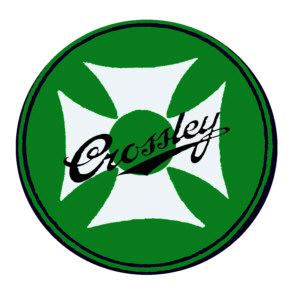
Crossley Motors was an English motor vehicle manufacturer based in Manchester, England. It produced approximately 19,000 cars from 1904 until 1938, 5,500 buses from 1926 until 1958, and 21,000 goods and military vehicles from 1914 to 1945.
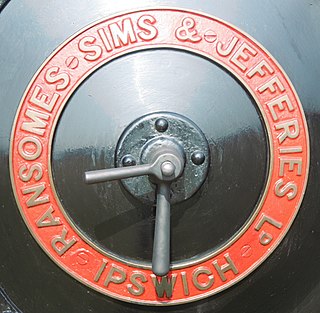
Ransomes, Sims and Jefferies Limited was a major British agricultural machinery maker also producing a wide range of general engineering products in Ipswich, Suffolk including traction engines, trolleybuses, ploughs, lawn mowers, combine harvesters and other tilling equipment. Ransomes also manufactured Direct Current electric motors in a wide range of sizes, and electric forklift trucks and tractors. They manufactured aeroplanes during the First World War. Their base, specially set up in 1845, was named Orwell Works.

Guy Motors was a Wolverhampton-based vehicle manufacturer that produced cars, lorries, buses and trolleybuses. The company was founded by Sydney S. Guy (1885–1971) who was born in Kings Heath, Birmingham. Guy Motors operated out of its Fallings Park factory from 1914 to 1982, playing an important role in the development of the British motor industry.

LiAZ is a bus manufacturing company located in Likino-Dulyovo, Russia. It is now a wholly owned subsidiary of GAZ. Specializes in designing and manufacturing buses large and extra large class.
The Mexborough and Swinton Traction Company was the name adopted by the Mexborough & Swinton Tramways Company in 1929 following the introduction of trolleybuses on all its routes. It operated in the West Riding of Yorkshire, England, over routes serving Manvers Main Colliery, Wath upon Dearne and the towns of Rotherham, Rawmarsh, Swinton, Mexborough, Conisbrough and the estate at Conanby.

Società Italiana Ernesto Breda, more usually referred to simply as Breda, is an Italian mechanical manufacturing company founded by Ernesto Breda in Milan in 1886.
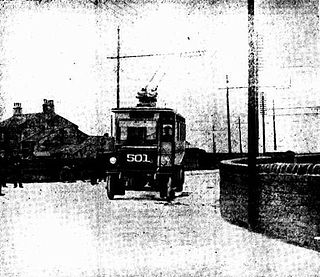
The Leeds trolleybus system served the West Riding of Yorkshire city of Leeds in England between 1911 and 1928. In May 2016, plans to construct a new system, the New Generation Transport (NGT) project, were refused approval from the UK Department for Transport, following a negative report from the planning inquiry.
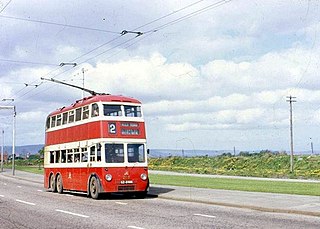
The Belfast trolleybus system served the city of Belfast, Northern Ireland. It was the only trolleybus system built in Ireland. Opened on 28 March 1938, it gradually replaced the city’s tramway network.

The Doncaster trolleybus system once served the town of Doncaster, South Yorkshire, England. Opened on 22 August 1928, it gradually replaced the Doncaster Corporation Tramways. By the standards of the various now-defunct trolleybus systems in the United Kingdom, the Doncaster system was a moderately sized one, with a total of 6 routes, all radiating out from the town centre, and a maximum fleet of 47 trolleybuses. The Bentley route was the first to close, on 12 February 1956, and the Beckett Road route was the last to go, on 14 December 1963.
Aberdare Urban District Council Tramways operated a tramway service in Aberdare between 1913 and 1935. It was the only system in the United Kingdom which consisted of a tramway with feeder services run by trolleybuses from the start. The trolleybuses used the Austrian Cedes-Stoll system, and became increasingly difficult to maintain. Parts of the trolleybus network were converted to tramways in the early 1920s, and the rest stopped operating in 1925, when no trolleybuses were available for service. The tramway continued for another ten years, but was closed in 1934 and 1935 as a result of a downturn in the prosperity of Aberdare, due to collieries closing and the population dwindling. Motor buses took over the local services once the tramway had closed.

Alfa Romeo 140AF is an Italian trolleybus produced from 1949 to 1960.

Changzhou Changjiang Bus was a bus manufacturer based in Changzhou, Jiangsu, China. Changzhou Changjiang was reported to be the largest bus builder in China. Buses are manufactured under the Changjiang brand.
Interserve Rail is a British engineering and facilities management company. Founded in 1910, it is a subsidiary of Interserve.
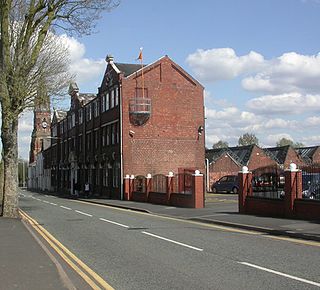
Sunbeam Commercial Vehicles was a commercial vehicle manufacturing offshoot of the Wolverhampton based Sunbeam Motor Car Company when it was a subsidiary of S T D Motors Limited. Sunbeam had always made ambulances on modified Sunbeam car chassis. S T D Motors chose to enter the large commercial vehicle market in the late 1920s, and once established they made petrol and diesel buses and electrically powered trolleybuses and milk floats. Commercial Vehicles became a separate department of Sunbeam in 1931.

The AEC 661T was a two-axle double deck trolleybus chassis manufactured by AEC between 1931 and 1942. Based on the AEC Regent bus chassis, 330 were built for United Kingdom operators.
The AEC 662T was a two-axle single deck trolleybus chassis manufactured by AEC between 1931 and 1935. A single deck version of the AEC 661T, 21 were built for English operators in Darlington (11) and Nottinghamshire and Derbyshire (10).
The AEC 663T was a three-axle double deck trolleybus chassis manufactured by AEC between 1931 and 1937. Based on the AEC Renown bus chassis, three demonstrators were bodied by English Electric in 1930. Eighty-three were built for English operators including 60 for London United Tramways.

The AEC 761T was a two-axle double deck trolleybus chassis manufactured by AEC. Based on the AEC Q-type bus chassis, only five were built; a demonstrator that was later purchased by Bradford, one in Southend-on-Sea and three exported to Sydney, Australia.
Railless is the generic name for three companies which made trolleybuses in Britain between 1906 and 1926. Railless Electric Traction Co Ltd was established in 1908, and were at the forefront of the introduction of trolleybuses to Britain. Financial difficulties in 1911 resulted in RET Construction Co Ltd being formed, to take over the business, goodwill and patents of Railless Electric Traction. This company ran out of orders during the First World War, and went into receivership. Charles H. Roe took over the bodywork part of the business, using RET's works in Leeds, and the goodwill and patents were sold to Railless Ltd, a new company which had been set up by Short Bros Ltd, and manufacture of the chassis transferred to their Seaplane works at Rochester, Kent.
References
- ↑ Lockwood, Stephen (2017). A-Z of British Trolleybuses. Marlborough: Crowood Press. ISBN 9781785002885.